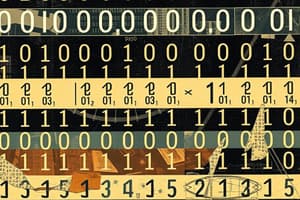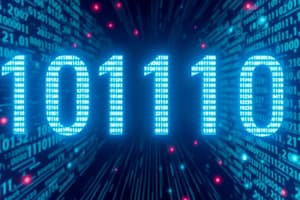Podcast
Questions and Answers
What is the term 'bit' short for?
What is the term 'bit' short for?
- Basic integer type
- Boolean information tag
- Byte identifier token
- Binary digit (correct)
In the binary numbering system, what does a turned off bit represent?
In the binary numbering system, what does a turned off bit represent?
- 1
- 10
- 2
- 0 (correct)
What does ASCII stand for in computer memory representation?
What does ASCII stand for in computer memory representation?
- Analog Signal Conversion and Interpretation
- Advanced String Code for Input and Output
- Automated System for Character Interface
- American Standard Code for Information Interchange (correct)
How are characters stored in a computer's memory?
How are characters stored in a computer's memory?
What is the purpose of a program in the context of a computer?
What is the purpose of a program in the context of a computer?
Why is the CPU often referred to as the 'computer's brain'?
Why is the CPU often referred to as the 'computer's brain'?
What are the limitations of the ASCII character set?
What are the limitations of the ASCII character set?
What distinguishes Unicode from ASCII in terms of character representation?
What distinguishes Unicode from ASCII in terms of character representation?
What is the purpose of writing instructions in 0s and 1s for a CPU?
What is the purpose of writing instructions in 0s and 1s for a CPU?
Why are machine language instructions always written in binary?
Why are machine language instructions always written in binary?
Why was assembly language created as an alternative to machine language?
Why was assembly language created as an alternative to machine language?
What is the significance of copying a program into main memory, or RAM, each time the CPU executes it?
What is the significance of copying a program into main memory, or RAM, each time the CPU executes it?
Flashcards are hidden until you start studying
Study Notes
- A computer's memory is divided into tiny storage locations called bytes, each byte is further divided into eight smaller storage locations called bits.
- A bit can represent one of two values depending on whether it's turned on or off, making it suitable for binary numbering system.
- Characters, including letters and punctuation marks, are stored in computer memory as binary numbers.
- Programs are usually stored on secondary storage devices like disk drives and are copied into main memory (RAM) each time they're executed by the CPU.
- CPU is the central processing unit of a computer that runs programs by performing simple operations on pieces of data. It doesn't understand instructions written in human languages; instead, it uses machine language written in binary code.
- Assembly language was created as an alternative to machine language, using short words called mnemonics instead of binary numbers for instructions.
- ASCII (American Standard Code for Information Interchange) is an important coding scheme for representing characters in computer memory, defining codes for 128 characters including English letters and various punctuation marks.
- Unicode is a more extensive encoding scheme that's compatible with ASCII and can represent characters of many world languages, surpassing ASCII's 128 character limit.
- A program is a list of instructions that tells the CPU to perform specific operations, with each instruction being a command for the CPU.
Studying That Suits You
Use AI to generate personalized quizzes and flashcards to suit your learning preferences.




